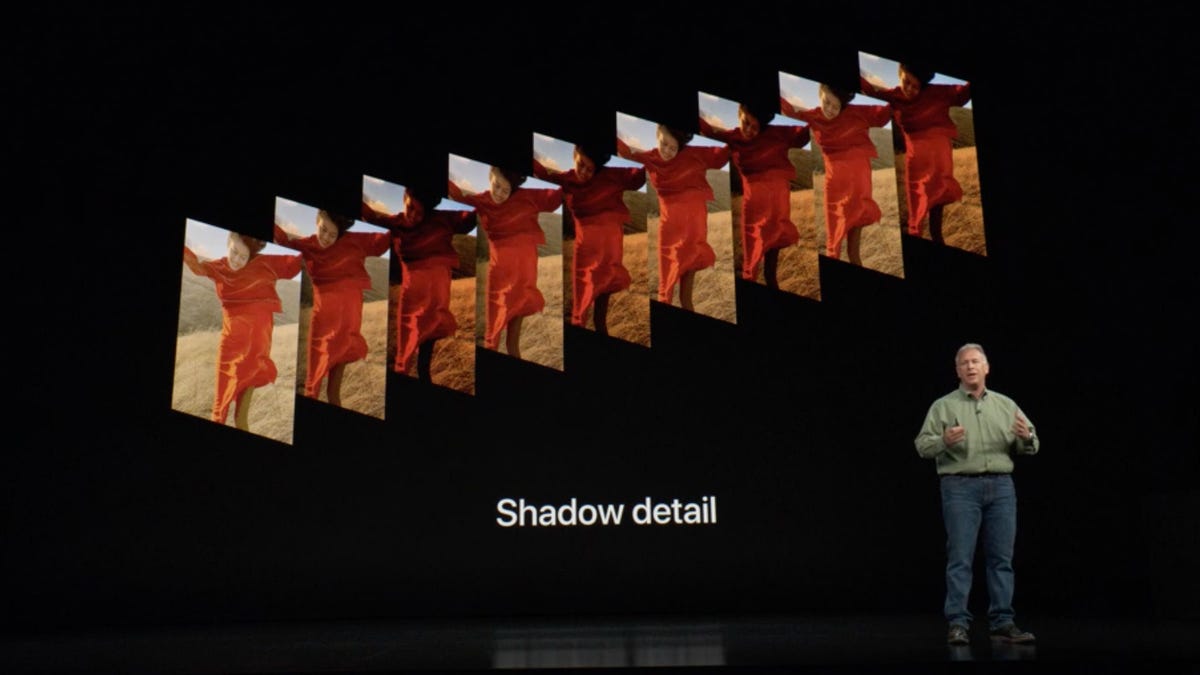iPhone XS camera gets new Smart HDR photos and adjustable bokeh
Also new in its flagship phones: a new bigger, better image sensor.

Apple marketing chief Phil Schiller says Smart HDR will improve iPhone XS photos' ability to capture both shadow details and bright highlights.
Apple's new iPhone XS and XS Max smartphones got two big camera features that today's iPhone X lacks: an improved HDR mode and a bokeh adjustment slider.
HDR, short for high dynamic range, is a technology that marries multiple photos into one shot to better capture both shadow details and bright highlights. A new technique called Smart HDR does better, Apple marketing chief Phil Schiller said Wednesday at Apple's iPhone launch event.
One change is that the iPhone XS picks from more source photos, including "interframe" shots at darker exposures. That should mean the resulting HDR is better able to avoid blown-out bright areas, Schiller said.
"It makes taking photos easier than ever to get beautiful results," Schiller said.
It's also a step toward Google's HDR approach in its Pixel smartphones, which stacks multiple underexposed shots into an HDR shot to control the highlights.
Photography is a critical feature for new smartphones. Most phone models don't change enough from one year to the next to get people to upgrade often, but camera improvements can make photography appreciably better in just 12 months.
See also
The new iPhone XS models also have a slider that lets you adjust how out of focus the background is behind a photos's subject -- a quality known in photography circles as bokeh. It's a significant advance over the previous depth effect, which was either on or off. Apple calls the feature depth control.
In a refinement to Apple's portrait mode, the iPhone XS, XS Max and XR come with a slider to adjust the amount of background blur, called bokeh.
The slider at the bottom of the photo frame shows lens apertures of f1.4 to f16, a simulation of the physical hardware in traditional lens cameras.
The new iPhone XR also gets the Smart HDR and depth control features, Schiller said.
Better camera sensors
The new phones still have 12-megapixel image sensors, but the sensors themselves are physically larger and image processing is faster. Larger sensors let digital camera makers improve image quality including dynamic range and color. The XS models also have Apple-designed lenses, Schiller said.
The front-facing camera on the iPhone XR gets a major update over 2017's phones. It has a 7 megapixel camera with a much faster sensor for higher-quality selfies, Schiller said.
The XS and XS Max both have dual cameras on the back of the phone, while the XR only has a single camera.
The XS and XS Max wide-angle camera has an f1.8 aperture. The other camera, with a more telephoto focal length set at twice the zoom as the wide-angle camera, has a narrower f2.4 aperture. That doesn't let in as much light, but that's a constraint of physics for all cameras with compact lenses. Both rear-facing cameras have optical image stabilization to compensate for shaky hands and smooth some jerkiness out of videos.
The faster phone sensors also mean that it'll be easier to scan and register your face for features like Face ID and Animojis, Apple said.
Apple, which became the first publicly traded company in the US with a trillion-dollar market capitalization in August, has been soaring over the past few years, largely thanks to the success of the iPhone. Apple makes about two-thirds of its revenue from the device, and the gadget also has helped its services businesses -- which includes the App Store and Apple Music -- grow quickly.
First published September 12, 11:32 a.m. PT
Update, 12:01 p.m. PT: Adds more detail about the cameras.
Taking It to Extremes: Mix insane situations -- erupting volcanoes, nuclear meltdowns, 30-foot waves -- with everyday tech. Here's what happens.
Fight the Power: Take a look at who's transforming the way we think about energy.



